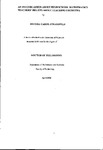AN INVESTIGATION ABOUT HIGH SCHOOL MATHEMATICS TEACHERS' BELIEFS ABOUT TEACHING GEOMETRY
| dc.contributor.author | STRASSFELD, BRENDA CAROL | |
| dc.contributor.other | School of Engineering, Computing and Mathematics | en_US |
| dc.date.accessioned | 2013-09-13T11:38:08Z | |
| dc.date.available | 2013-09-13T11:38:08Z | |
| dc.date.issued | 2008 | |
| dc.identifier | NOT AVAILABLE | en_US |
| dc.identifier.uri | http://hdl.handle.net/10026.1/1701 | |
| dc.description.abstract |
There continues to exist a dilemma about how, why and when geometry should be taught. The aim of this study was to examine high school mathematics teachers' beliefs about geometry and its teaching with respect to its role in the curriculum, the uses of manipulatives and dynamic geometry software in the classroom, and the role of proofs. In this study belief is taken as subjective knowledge (Furinghetti and Pehkonen, 2002). Data were collected from 520 teachers using questionnaires that included both statements that required responses on a Likert scale and open-ended questions. Also an intervention case study was conducted with one teacher. A three factor solution emerged from the analysis that revealed a disposition towards activities, a disposition towards an appreciation of geometry and its applications and a disposition towards abstraction. These results enabled classification of teachers into one of eight groups depending on whether their scores were positive or negative on the three factors. Knowing the teacher typology allows for appropriate professional development activities to be undertaken. This was done in the case study where techniques for scaffolding proofs were used as an intervention for a teacher who had a positive disposition towards activities and appreciation of geometry and its applications but a negative disposition towards abstraction. The intervention enabled the teacher successfully to teach her students how to understand and construct proofs. The open-ended responses on the questionnaire were analysed to obtain a better understanding of the teachers' beliefs. Four themes, the formal, intuitive, utilitarian and the mathematical, emerged from the analysis, which support the modal arguments given by Gonzalez and Herbst (2006). The findings reveal a disconnect between some high school teachers' beliefs about why geometry is important to study and the current position of the Standards Movement; and between whether geometry should be taught as part of an integrated curriculum or as a one-year course. | en_US |
| dc.language.iso | en | en_US |
| dc.publisher | University of Plymouth | en_US |
| dc.title | AN INVESTIGATION ABOUT HIGH SCHOOL MATHEMATICS TEACHERS' BELIEFS ABOUT TEACHING GEOMETRY | en_US |
| dc.type | Thesis | |
| plymouth.version | Full version | en_US |
| dc.identifier.doi | http://dx.doi.org/10.24382/3325 |
Files in this item
This item appears in the following Collection(s)
-
01 Research Theses Main Collection
Research Theses Main


